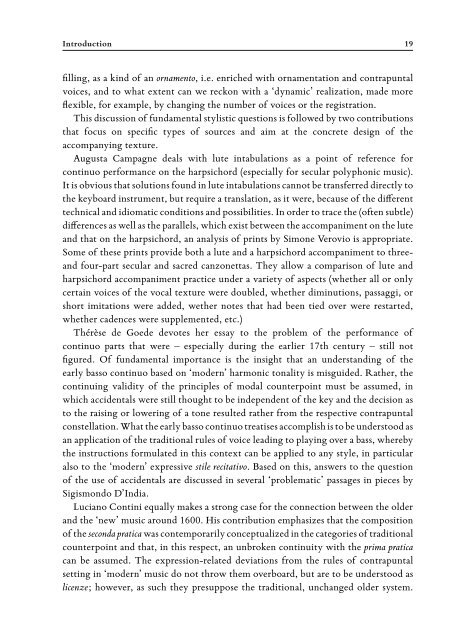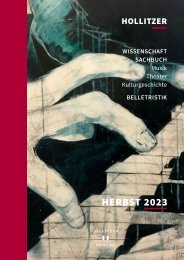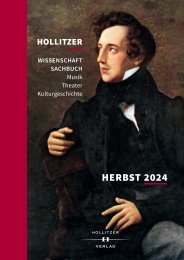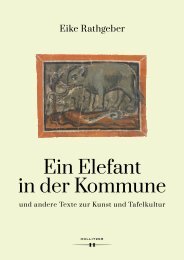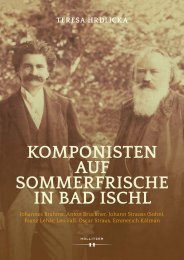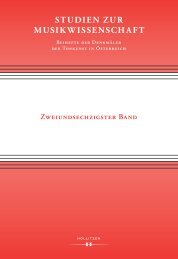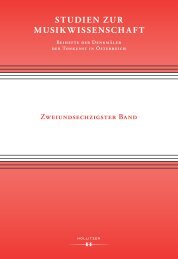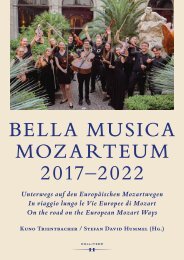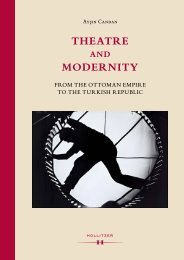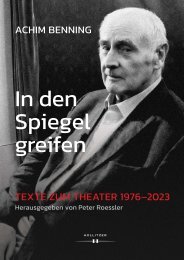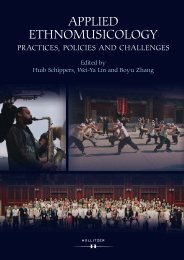Leseprobe_Anklaenge 2020-2021
Erfolgreiche ePaper selbst erstellen
Machen Sie aus Ihren PDF Publikationen ein blätterbares Flipbook mit unserer einzigartigen Google optimierten e-Paper Software.
Introduction<br />
19<br />
filling, as a kind of an ornamento, i.e. enriched with ornamentation and contrapuntal<br />
voices, and to what extent can we reckon with a ‘dynamic’ realization, made more<br />
flexible, for example, by changing the number of voices or the registration.<br />
This discussion of fundamental stylistic questions is followed by two contributions<br />
that focus on specific types of sources and aim at the concrete design of the<br />
accompanying texture.<br />
Augusta Campagne deals with lute intabulations as a point of reference for<br />
continuo performance on the harpsichord (especially for secular polyphonic music).<br />
It is obvious that solutions found in lute intabulations cannot be transferred directly to<br />
the keyboard instrument, but require a translation, as it were, because of the different<br />
technical and idiomatic conditions and possibilities. In order to trace the (often subtle)<br />
differences as well as the parallels, which exist between the accompaniment on the lute<br />
and that on the harpsichord, an analysis of prints by Simone Verovio is appropriate.<br />
Some of these prints provide both a lute and a harpsichord accompaniment to threeand<br />
four-part secular and sacred canzonettas. They allow a comparison of lute and<br />
harpsichord accompaniment practice under a variety of aspects (whether all or only<br />
certain voices of the vocal texture were doubled, whether diminutions, passaggi, or<br />
short imitations were added, wether notes that had been tied over were restarted,<br />
whether cadences were supplemented, etc.)<br />
Thérèse de Goede devotes her essay to the problem of the performance of<br />
continuo parts that were – especially during the earlier 17th century – still not<br />
figured. Of fundamental importance is the insight that an understanding of the<br />
early basso continuo based on ‘modern’ harmonic tonality is misguided. Rather, the<br />
continuing validity of the principles of modal counterpoint must be assumed, in<br />
which accidentals were still thought to be independent of the key and the decision as<br />
to the raising or lowering of a tone resulted rather from the respective contrapuntal<br />
constellation. What the early basso continuo treatises accomplish is to be understood as<br />
an application of the traditional rules of voice leading to playing over a bass, whereby<br />
the instructions formulated in this context can be applied to any style, in particular<br />
also to the ‘modern’ expressive stile recitativo. Based on this, answers to the question<br />
of the use of accidentals are discussed in several ‘problematic’ passages in pieces by<br />
Sigismondo D’India.<br />
Luciano Contini equally makes a strong case for the connection between the older<br />
and the ‘new’ music around 1600. His contribution emphasizes that the composition<br />
of the seconda pratica was contemporarily conceptualized in the categories of traditional<br />
counterpoint and that, in this respect, an unbroken continuity with the prima pratica<br />
can be assumed. The expression-related deviations from the rules of contrapuntal<br />
setting in ‘modern’ music do not throw them overboard, but are to be understood as<br />
licenze; however, as such they presuppose the traditional, unchanged older system.


